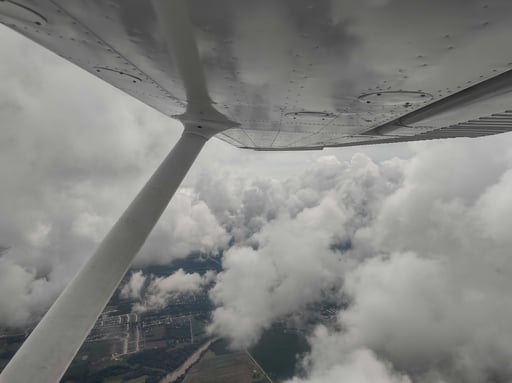As a student pilot, navigating low clouds in San Diego can be a challenging task. Any experienced pilot in Southern California knows about the "marine layer," a broken to overcast layer of clouds that's usually most prevalent in the early morning and near sunset along the coastline. With proper planning and execution, you can safely navigate through these conditions.
What is the San Diego the Marine layer?
 The marine layer in San Diego is a coastal atmospheric condition where cool, moist air from the ocean gets trapped beneath a layer of warmer, drier air above. The colder wetter air originates from over the cold ocean waters, but the air is pulled inland by temperature differences. The result is overcast conditions along the coast, occasionally the clouds and fog will reach inland areas.
The marine layer in San Diego is a coastal atmospheric condition where cool, moist air from the ocean gets trapped beneath a layer of warmer, drier air above. The colder wetter air originates from over the cold ocean waters, but the air is pulled inland by temperature differences. The result is overcast conditions along the coast, occasionally the clouds and fog will reach inland areas.
The marine layer occurs year round but along the coast but is more severe in the late spring and early summer months. This is referred to by the locals as "May Gray" and "June Gloom". The marine layer usually dissipates or "burns off" by the afternoon due to the sun's heat, but on some days, the layer remains persistent. Navigating these areas of low visibility offers unique challenges to pilots, particularly those new to the region or still in training.
How to Navigate The San Diego Marine Layer
- Understand the Forecast: The first step in navigating low clouds is to check the weather forecast before your flight. This will give you an idea of the cloud coverage and visibility in the area, and allow you to plan your flight accordingly. If the forecast calls for low clouds and visibility, it is best to reschedule your flight for a different day.
- Recognize the Unique Nature of the Marine Layer: Unlike typical clouds, the marine layer is formed by cool, moist ocean air being trapped beneath a layer of warmer, dry air. It's most pronounced in the mornings and evenings, especially along the coastline, and dissipates as you move inland.
- Adherence to Flight Rules: If you must fly in low cloud conditions, it is important to stay within the parameters of your flight rules, or if you're a solo, following the limitations of your solo endorsement to the letter. This includes staying within your visual flight rules (VFR) minimums and staying clear of any restricted airspace. Additionally, you should always stay in communication with air traffic control and follow their instructions.
- Situational Awareness: Another key aspect of navigating low clouds is to stay aware of your surroundings at all times. This includes keeping an eye on your instruments and maintaining a constant lookout for other aircraft. It is also important to stay at a safe altitude and avoid flying too close to the clouds.
- Remember the Fundamentals: When flying in low clouds, it is also important to stay calm and remember the fundamentals: Aviate, Navigate, and Communicate, in that order. This will help you to focus and make better decisions, which can ultimately help you to navigate around the clouds safely.
- The Value of Local Knowledge: Talking to local pilots and instructors can provide invaluable insights. Their experiences with the marine layer can offer you strategies, personal stories, and best practices.
- Flight Planning Tools: Make use of detailed weather tools like METARs, TAFs, and satellite imagery. Advanced instruments like the Skew-T log-P diagrams can provide insights into atmospheric profiles, helping predict the marine layer's depth and persistence.
- Alternate Airports: If the marine layer proves challenging upon arrival in San Diego, having a list of alternate inland airports can be a lifesaver, offering clearer conditions.
- The Role of the Pilot-in-Command: Always remember that you are the pilot in command and it is your responsibility to make the final decision regarding the safety of your flight. If at any point you feel uncomfortable or uncertain, it is best to abort the flight and return to your home airport.
Navigating low clouds in San Diego as a student pilot can be challenging, but with proper planning, execution, and awareness, you can safely train in these conditions. Always stay within the parameters of your flight plan, stay aware of your surroundings, and remember that safety should always be your top priority.
San Diego has a lot to teach pilots and learning to navigate the marine layer is just one of the many reasons that flight training in San Diego is great. But we have to be honest, we love teaching people to fly in San Diego because of the amazing San Diego training flights you can take.
If you'd are interested in a Flight School in San Diego, Flex Air can help you get you private pilot's license or to become a commercial pilot.

